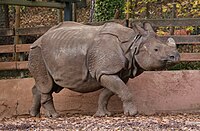Pachydermata
Pachydermata(meaning 'thick skin', from theGreekπαχύς,pachys,'thick', andδέρμα,derma,'skin') is an obsoleteorderofmammalsdescribed byGottlieb Storr,Georges Cuvier,and others, at one time recognized by manysystematists.The termpachydermis commonly used to describeelephants,rhinoceroses,hippopotamusesandtapirs.The grouping was determined to be artificial as a biological classification due to genetic studies.
Description
[edit]Pachydermata is an obsoleteorderofmammalsdescribed byGottlieb Storr,Georges Cuvier,and others, at one time recognized by manysystematists.The grouping ispolyphyletic,so the order is no longer in use as a biological classification.[when?]Outside strictbiological classification,the related termpachydermis commonly used to describeelephants,rhinoceroses,hippopotamusesandtapirs.
Cuvier himself definedPachydermataas "animals with hoofs, nonruminants",whereasStorrhad described it as "mammals with hoofs with more than two toes". The classificationPachydermataincluded the three families of mammals he calledProboscidiana,Pachydermata Ordinaria,andSolipedes,which are allherbivorous.[1]The members of the grouping are now divided into theProboscidea(represented among living species only bythree species of elephants), thePerissodactyla(odd-toed ungulates,includinghorses,tapirs,andrhinoceroses), theSuina(pigsandpeccaries), theHippopotamidae,Hyracoidea(hyraxes) and Sirenians (Manateeanddugong).
The term is important in the history ofsystematics.Although the former order of Pachydermata is often described as an artificial grouping of unrelated mammals, it was recognised by notablezoologists,includingCharles Darwin,as a grade ofhoofedmammals to the exception of otherungulates;and anatomical characters support the affinities of "pachyderm" mammals to each other and to other ungulates.
History
[edit]In a series of research papers published in 1796, Georges Cuvier created the classificationPachydermata.[1]Cuvier added horses to the order.[2]One naturalist,Delabere Pritchett Blaine,has speculated that:
Baron Cuvier, it is probable, was led to arrange the horse genus among the Pachydermata, less on account of the thickness and tenacity of the skin, than on the slight departure from a truemonodactylouscharacter, which every member of this family exhibits in having vestiges of two additional toes under the skin.
— Delabere Pritchett Blaine, An Encyclopaedia of Rural Sports, Vol. 1, page 240
According togenetic studies,elephants, rhinoceroses, tapirs and hippopotamuses are classified as separatecladesaltogether. Rhinos, hippos, pigs, peccaries, horses,zebras,donkeysand tapirs are classified in cladeLaurasiatheria,while elephants, hyraxes,manateesanddugongsare classified in cladeAfrotheria.
References
[edit]- ^abTenney, Sanborn (1867).Natural History: A Manual of Zoölogy for Schools, Colleges and the General Reader.Charles Scribner & Company.p. 86.
- ^'History of the Works of Cuvier' in United States Congress,House Documents, Otherwise Publ. as Executive Documents(1869). p 159


